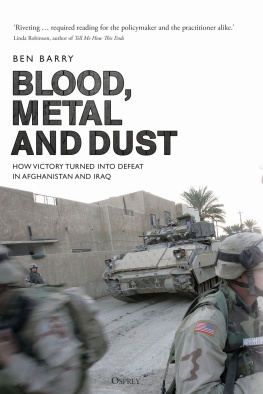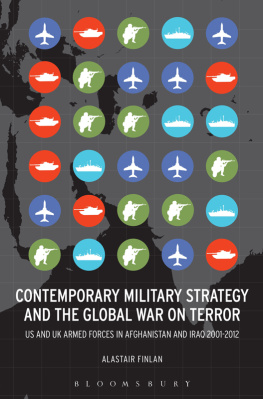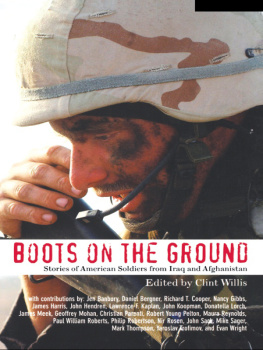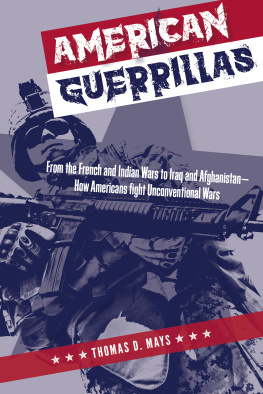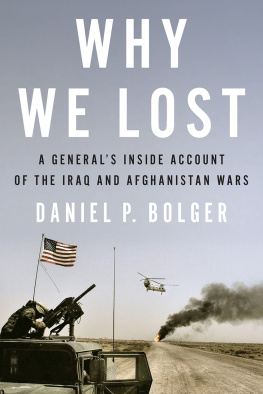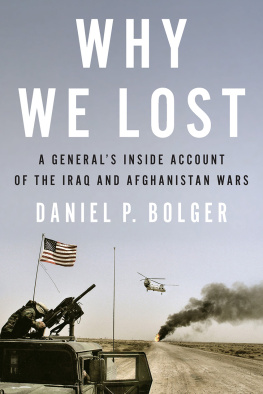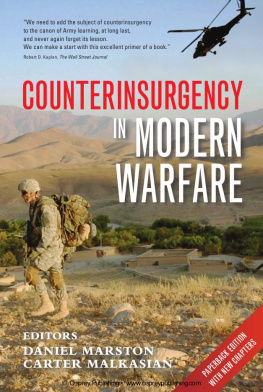The Manhattan skyline following the terrorist attacks on the World Trade Centre, September 2001. (Getty Images) |
A US Air Force combat controller watches as another airstrike hits Taliban positions. (US Army) |
US Army SOF travelling on horses to support General Dostums militia, Afghanistan, 2001. (USASOC) |
Commander CENTCOM General Tommy Franks meets with US SOF in Afghanistan. (USASOC) |
A British paratrooper with ISAF outside Kabuls Darulaman Palace, February 2002. (Getty Images) |
US troops searching for jihadist fighters in the Shah-i Kowt mountains after Operation Anaconda . (Getty Images) |
A B2 Spirit stealth bomber at the Diego Garcia airfield. (TSgt Richard Freeland) |
Lieutenant General James Conway and Major General James Mattis. (USMC) |
A US Marine inspects the burned-out hulk of C211, the first AMTRAC hit in Ambush Alley. (USMC) |
An M1 Abrams tank being used by a fighter pilot acting as a Forward Air Controller (FAC) in Iraq. (USMC) |
A US M1 Abrams tank takes part in the capture of Baghdad Airport, April 2003. (Getty Images) |
Mechanized infantry with their Bradley infantry fighting vehicle patrol in Baghdad, April 2003. (Getty Images) |
A Warrior fighting vehicle and soldier of the Irish Guards outside Basra, April 2003. (Crown Copyright 2020) |
Secretary of Defense Rumsfeld with Lieutenant General Wallace and Lieutenant General McKiernan, April 2003. (DoD) |
A peaceful demonstration in Kut, monitored by US troops and a TV network cameraman. (USMC) |
An Iraqi mother and children raise their hands as US troops search their home in Tikrit, December 2003. (Getty Images) |
CPA head Paul Bremer and CJTF-7 commander Lieutenant General Ricardo Sanchez in Baghdad, April 2004. (Getty Images) |
US Marines take cover in front of an HMMWV during the first battle of Fallujah, April 2004. (USMC) |
US Army infantry in Fallujah. (US Army) |
Abu Musab al-Zarqawi, self-proclaimed leader of Al Qaida in Iraq. (Getty Images) |
Shia militia fighters loyal to radical Iraqi cleric Muqtada al-Sadr in Najaf, August 2004. (Getty Images) |
A US Army Stryker wheeled APC with two of its infantry crew in Mosul, 2005. (US Army) |
Wounded Iraqis in the emergency room of a hospital in Baghdad, July 2005, after a suicide bomb attack. (Getty Images) |
A British soldier prepares to jump from a burning Warrior, Basra, September 2005. (Reuters) |
General George Casey and Prime Minister Nouri al-Maliki, September 2006. (Getty Images) |
Rangers conduct a night operation in Mosul, Iraq, December 2006. (75th Ranger Regiment) |
EFP roadside bombs in Husseiniyah, Iraq, 2007. (US Army) |
UK Prime Minister Tony Blair talks to British troops at divisional HQ in Basra, May 2007. (Getty Images) |
Protected Mobility (1). The British Bulldog tracked APC. (Crown Copyright 2020) |
Protected Mobility (2). Mine Resistant Ambush Protected (MRAP) personnel carrier. (US Army) |
Iraqi police and 82nd Airborne Division paratroopers patrol Adhamiyah in Baghdad in early 2007. (US Army) |
General David Petraeus, Secretary of Defense Robert Gates and US Ambassador Ryan Crocker in Baghdad, June 2007. (DoD) |
Sons of Iraq staff a checkpoint in Himbus, Iraq, March 2008. (US Army) |
Shia militia celebrate the destruction of an Iraqi Army vehicle in Baghdad, March 2008. (Getty Images) |
A British mentoring team deploys on Operation Charge of the Knights in the Mastiff protected mobility vehicle. (Crown Copyright 2020) |
Combat engineers constructing the concrete barrier Gold Wall during the battle of Sadr City. (US Army) |
Iraqi Army troops cross the Gold Wall to clear the rest of Sadr City, May 2008. (Getty Images) |
Canadian and Afghan troops in Panjwai District, Kandahar Province, Autumn 2006. (Getty Images) |
US paratroops fight off a Taliban ambush in Afghanistan, August 2007. (US Army) |
A British bomb disposal robot disrupts a suspected IED in Afghanistan. (Crown Copyright 2020) |
British troops disembark from a Chinook helicopter in Helmand Province, May 2009. (Crown Copyright 2020) |
British troops rush a casualty to a USAF helicopter in Helmand, summer 2009. (Crown Copyright 2020) |
An Afghan Army commando with a US SOF advisor searches for IEDs in Marjah, 2009. (US Army) |
A US Army soldier watches F-15 fighter jets destroy insurgent positions in the Korengal Valley, Kunar Province, August 2009. (US Army) |
US Army Staff Sergeant Clinton Romesha near Combat Outpost Keating, Nuristan Province, Afghanistan. (US Army) |
A US soldier cleans his machine gun at an observation post in Paktika Province, November 2009. (US Army) |
Afghan soldiers use hand-held mine detectors to search a track for IEDs, Helmand Province, December 2010. (Crown Copyright 2020) |
British mentors advise an Afghan Army officer near Gereshk, Afghanistan, October 2010. (Crown Copyright 2020) |
General Stanley McChrystal briefs President Hamid Karzai in Kabul, April 2010. (Getty Images) |
US Army Rangers clear a room in Kandahar Province. (DoD) |
US soldiers during a firefight with Taliban forces in Kunar Province, Afghanistan, March 2011. (US Army) |
A US Army counter-IED team blows up a roadside bomb in Panjwai district, Kandahar Province, January 2012. (US Army) |
State Department representative Carter Malkasian with Garmser police chief Omar Jan. (Getty Images) |
A combat patrol of M1 tanks overlooking the Helmand River, September 2013. (USMC ) |
A Reaper UAV armed with Hellfire missiles lands at Kandahar airfield. (Crown Copyright 2020) |
A US aerostat balloon, Afghanistan. (US Army) |
Female US Army Military Police in Zabul Province, Afghanistan, in September 2013. (US Army) |
A USAF A10 aircraft supporting the Afghan Army, Nangarhar Province, in March 2014. (Getty Images) |
A British Apache helicopter is loaded into a transport aircraft as the British leave Helmand Province, July 2014. (Crown Copyright 2020) |
Afghan soldiers, Taliban and civilians gather in Maiwand, Kandahar Province, during the June 2018 ceasefire for the festival of Eid. (Getty Images) |
Iraq and Afghanistan have been the dominant experience of this century for the land and air forces of the US and many of its allies. As a result, these forces have changed a great deal, as much as they changed in each of the previous centurys world wars. The wars have also resulted in changes to the key non-state actors, particularly the Taliban, Al Qaida and its offshoot ISIS. Thirteen years of fighting inflicted over 56,000 killed or seriously wounded casualties on the forces of the US. The wars probably caused about quarter of a million civilian casualties. The two wars cost the US alone over $1.5 trillion in additional military funding over and above the Pentagons annual budget.

